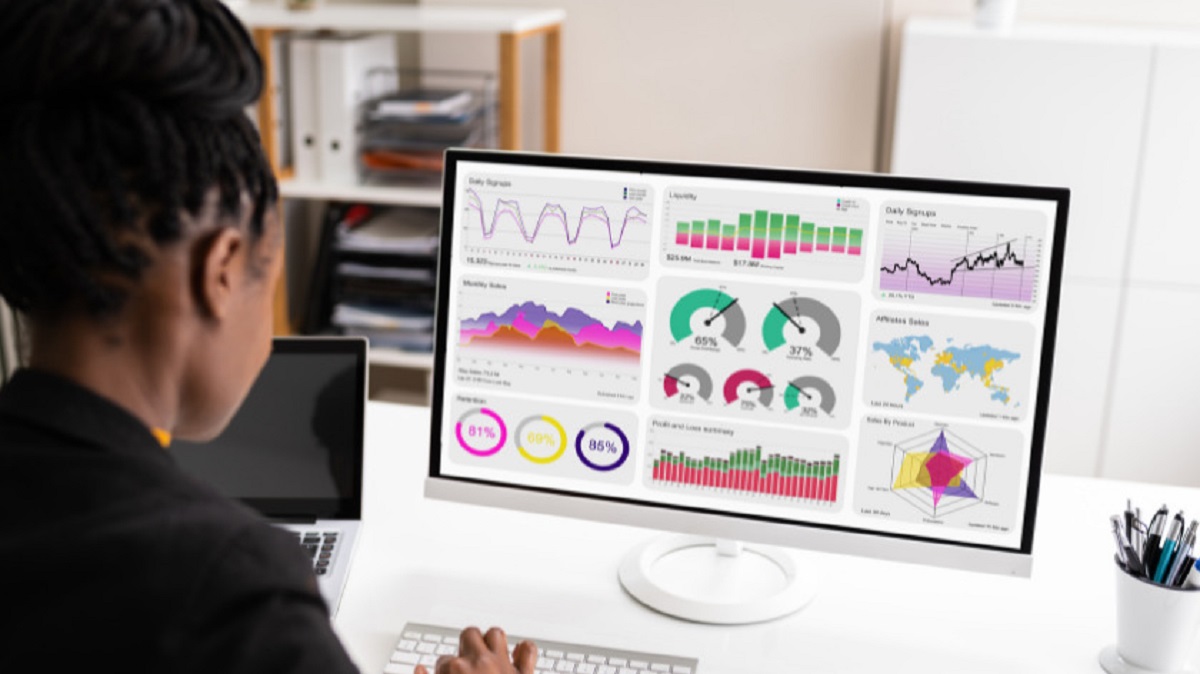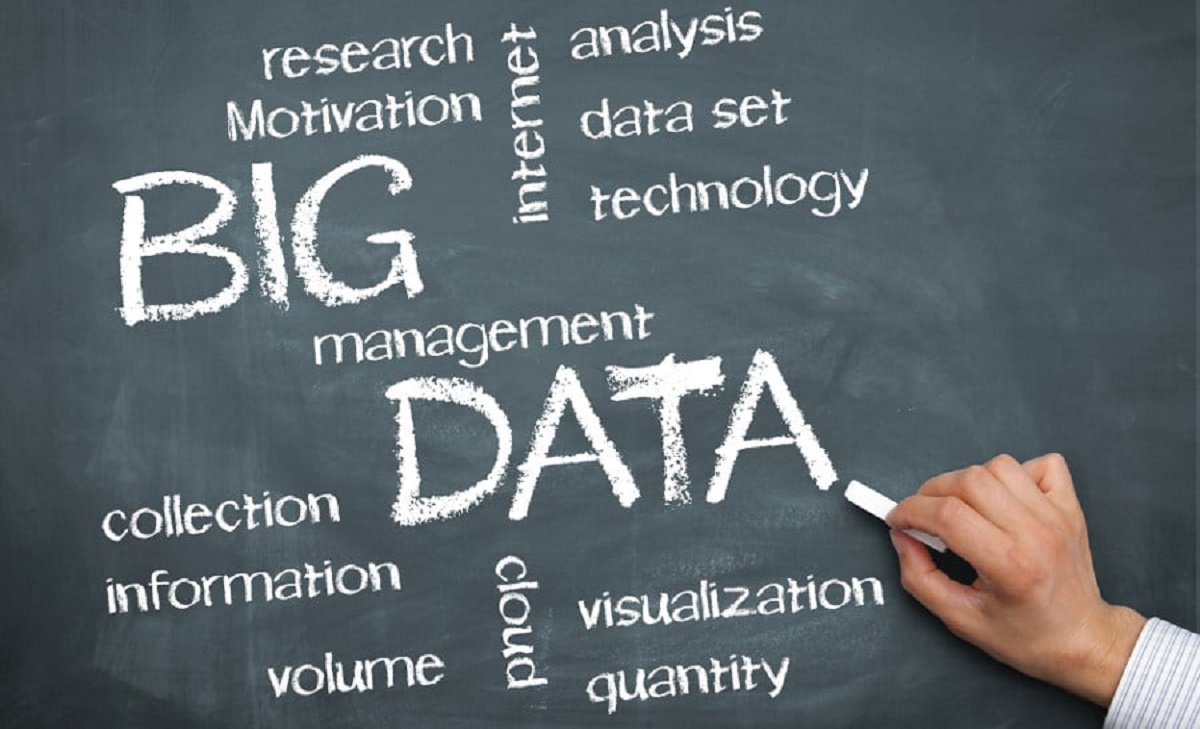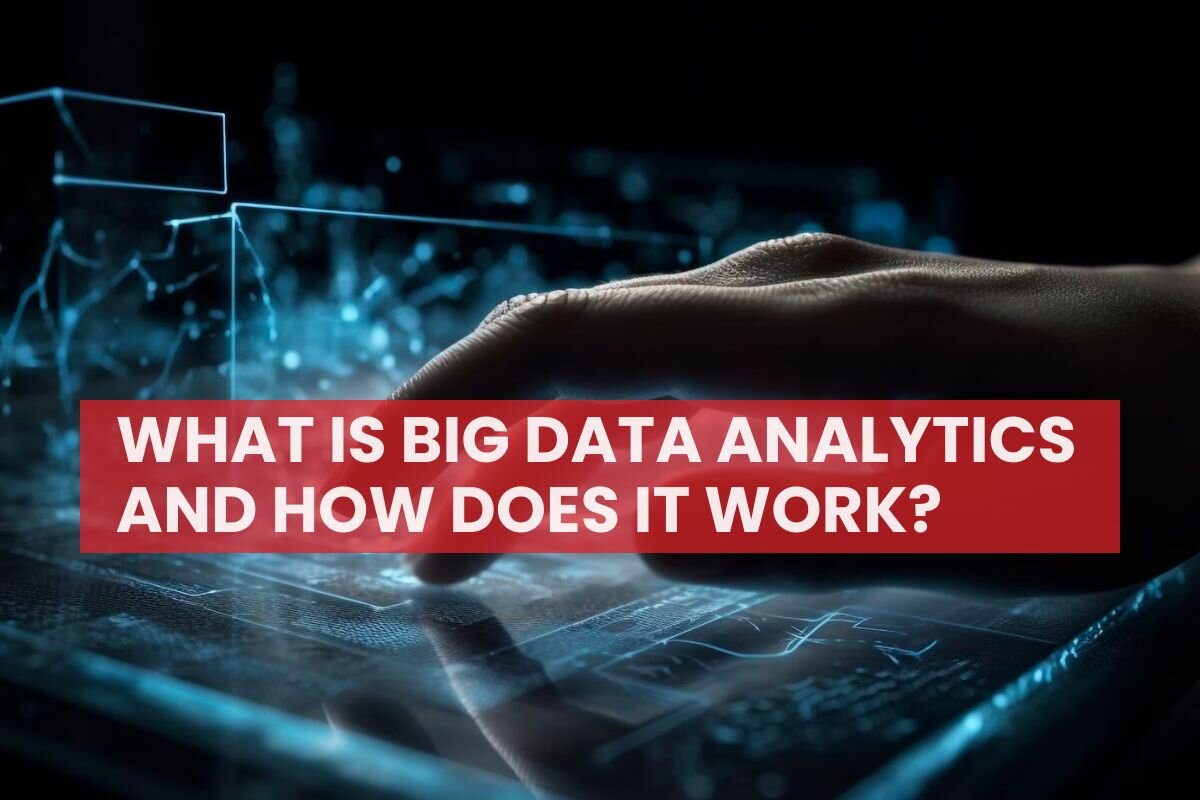Introduction
Welcome to the world of big data in marketing! In today’s digital age, data plays a crucial role in shaping the success of businesses across industries. Organizations are now able to collect vast amounts of data from various sources, ranging from customer interactions to social media activities. This abundance of data has led to the emergence of big data analytics, which leverages sophisticated algorithms and technologies to uncover valuable insights and drive marketing strategies.
Big data refers to the immense volume of structured and unstructured data that organizations accumulate on a daily basis. This data comes from a plethora of sources, such as web interactions, purchase history, social media posts, online surveys, and more. The massive amount of information collected presents both challenges and opportunities for marketers.
With the help of advanced analytics tools, marketers can now analyze these large datasets to gain valuable insights into customer behavior, market trends, and competitive landscapes. This wealth of information enables businesses to make data-driven decisions, enhance customer experiences, and ultimately drive revenue growth.
In this article, we will explore the various ways in which big data is utilized in marketing. From gaining deep consumer insights to optimizing marketing campaigns, big data has revolutionized the way businesses approach their marketing strategies. So, let’s dive in and discover the role of big data in shaping the future of marketing.
What is Big Data?
Big data refers to the vast and complex sets of structured and unstructured data that organizations collect and analyze to gain insights and make data-driven decisions. The term “big” in big data doesn’t refer to the size of the data alone; it also encompasses the velocity, variety, and variability of the data.
Traditional data management techniques and tools are often inadequate to process and analyze big data due to its sheer volume and velocity. Big data is characterized by the four V’s:
- Volume: Big data comes in massive quantities that cannot be handled by traditional databases. It includes data from various sources such as customer interactions, purchase history, web logs, social media posts, and more.
- Velocity: Big data is generated at an unprecedented speed. In today’s digital era, data is constantly being created and updated, requiring real-time or near-real-time analysis.
- Variety: Big data comes in diverse formats and types, including structured data (such as databases and spreadsheets) and unstructured data (such as emails, documents, images, audio, and video files).
- Variability: Big data is dynamic and subject to frequent change. It can have unpredictable patterns, making it challenging to analyze using traditional methods.
Big data analytics is the process of examining and uncovering meaningful patterns, insights, and correlations within large datasets. By leveraging advanced analytics techniques, such as machine learning and artificial intelligence, businesses can extract valuable information from big data to drive data-driven decision-making and gain a competitive advantage.
Organizations across industries are now harnessing the power of big data to gain a comprehensive understanding of their customers, optimize marketing campaigns, predict market trends, enhance operational efficiency, and develop innovative products and services.
As technology continues to advance, the volume and complexity of big data will only increase. Therefore, it is crucial for businesses to embrace big data analytics to effectively harness the potential of this vast resource and stay ahead in today’s data-driven economy.
The Role of Big Data in Marketing
Big data has significantly transformed the marketing landscape by enabling businesses to make data-driven decisions and deliver more personalized experiences to their customers. Let’s explore some key ways in which big data plays a crucial role in marketing:
- Consumer Insights: Big data analytics allows marketers to gain deep insights into consumer behavior, preferences, and purchasing patterns. By analyzing vast amounts of data, businesses can understand their customers’ needs, identify trends, and tailor their marketing strategies to meet specific target audience segments.
- Personalized Marketing: Leveraging big data, businesses can deliver highly personalized marketing messages and experiences. By analyzing customer data, such as past purchases, browsing history, and demographic information, organizations can create targeted campaigns that resonate with individual customers on a more personal level, ultimately driving engagement and boosting conversion rates.
- Predictive Analytics: Big data enables marketers to leverage predictive analytics models to forecast future trends and behaviors. By analyzing historical data and identifying patterns, businesses can make accurate predictions about customer preferences, market demand, and campaign performance, allowing them to proactively optimize their strategies and stay ahead of the competition.
- Campaign Optimization: Through big data analysis, businesses can gain real-time insights into the performance of their marketing campaigns. This allows marketers to identify what’s working and what’s not, enabling them to make data-driven adjustments and optimize their marketing efforts to achieve better results and ROI.
- Customer Segmentation: Big data plays a vital role in segmenting customers based on various attributes such as demographics, behavior, and preferences. By dividing the target audience into specific segments, marketers can create tailored marketing strategies for each segment, delivering personalized content and experiences that resonate with their unique needs and interests.
- Social Media Analytics: The massive amount of data generated on social media platforms provides valuable insights into customer sentiment, brand perception, and industry trends. Big data analytics tools allow marketers to analyze social media data in real-time, helping them understand customer opinions, track social media campaigns, and make data-driven decisions to enhance their social media marketing strategies.
- Real-time Data Analysis: With big data, businesses can analyze and act upon real-time data immediately. This capability allows marketers to respond promptly to customer interactions, optimize campaigns on the fly, and deliver timely and relevant messages to their target audience.
- Competitive Intelligence: Big data analytics enables businesses to gather and analyze data on their competitors, their marketing strategies, and market trends. This information gives marketers a competitive edge, allowing them to identify opportunities, establish benchmarks, and develop unique selling propositions that differentiate their brand from competitors.
- Fraud Detection: Big data analytics can help businesses detect and prevent fraudulent activities such as click fraud, identity theft, and payment fraud. By analyzing patterns and anomalies in data, marketers can identify suspicious activities and take necessary actions to protect their business and customers.
- Customer Experience Enhancement: By analyzing customer data across various touchpoints, businesses can gain insights into the customer journey and identify pain points or areas for improvement. Big data enables marketers to enhance the customer experience by personalizing interactions, resolving issues proactively, and delivering seamless experiences across multiple channels.
These are just a few examples of how big data is revolutionizing marketing. As businesses continue to embrace data-driven strategies, the role of big data in marketing will only grow in importance, providing endless opportunities for businesses to gain a competitive advantage and deliver superior experiences to their customers.
Consumer Insights
One of the key ways in which big data is transforming marketing is by providing businesses with valuable consumer insights. By analyzing vast amounts of data from various sources, including customer interactions, online behavior, purchase history, and social media activity, marketers can gain a comprehensive understanding of consumer preferences, behaviors, and needs.
With the help of big data analytics, businesses can segment their target audience based on demographics, interests, and purchasing patterns. This segmentation allows marketers to create more targeted and personalized marketing campaigns that resonate with different customer segments. By tailoring messages and offers to specific groups, businesses can improve engagement and conversion rates.
Big data also enables marketers to track and analyze customer interactions at each touchpoint along the customer journey. By analyzing this data, businesses can identify pain points or areas of improvement in the customer experience. For example, they can track website navigation patterns to identify pages that lead to high bounce rates or analyze customer feedback to address common issues or concerns.
Furthermore, big data analytics can uncover hidden patterns and correlations within customer data that may not be immediately apparent. By understanding these patterns, businesses can identify trends and make data-driven predictions about future customer behavior. This information is invaluable for developing effective marketing strategies, launching new products, and staying ahead of the competition.
With the advent of social media and the massive amounts of data generated on these platforms, big data has become an essential tool for understanding customer sentiment and brand perception. By analyzing social media conversations and mentions, businesses can monitor how customers perceive their brand and identify potential opportunities or challenges. This information can guide marketing efforts and help businesses connect with their target audience on a deeper level.
Overall, big data provides marketers with a wealth of information and insights into consumer behavior. By leveraging this data effectively, businesses can understand their customers better, develop targeted marketing strategies, and ultimately deliver more personalized and engaging experiences to their target audience.
Personalized Marketing
In today’s digital age, consumers expect personalized experiences from the brands they interact with. Big data has played a pivotal role in enabling businesses to deliver highly targeted and personalized marketing campaigns.
By leveraging big data analytics, businesses can collect and analyze vast amounts of customer data, including past purchases, browsing behavior, demographic information, and social media activity. This data provides valuable insights into individual customer preferences, interests, and needs.
With this wealth of information, marketers can create highly personalized marketing messages and offers tailored to each customer’s unique characteristics. Personalized marketing goes beyond simply addressing a customer by their name; it involves delivering content and recommendations that resonate with their specific interests and preferences.
For example, an online retailer can use data analysis to identify specific products or categories a customer has shown interest in and recommend similar items for future purchases. This level of personalization not only enhances the customer experience but also increases the likelihood of conversion and customer loyalty.
Personalized marketing also extends to delivering dynamic content based on real-time interactions. For instance, an e-commerce website can display targeted product recommendations in real-time based on a customer’s browsing behavior. This level of personalization creates a more engaging and relevant experience, increasing the chances of conversions and customer satisfaction.
Furthermore, personalization extends beyond digital channels. With the help of big data, businesses can integrate offline and online data to deliver personalized experiences across different touchpoints. For example, a brick-and-mortar retailer can incorporate customer data from loyalty programs and in-store interactions to provide customized offers and recommendations to shoppers.
Personalized marketing not only benefits customers but also drives business results. By delivering tailored marketing messages, businesses can increase customer engagement, improve conversion rates, and drive customer loyalty. Studies have shown that personalized marketing campaigns generate higher open and click-through rates compared to generic mass-marketing campaigns.
However, it’s important for businesses to navigate the ethical considerations of personalized marketing. Respecting customer data privacy and implementing transparent data collection practices are essential to maintain customer trust and comply with relevant regulations.
Overall, personalized marketing powered by big data enables businesses to create meaningful and relevant customer experiences. By leveraging customer insights, businesses can deliver targeted messages, recommendations, and offers that resonate with individuals, thereby enhancing customer satisfaction and driving business growth.
Predictive Analytics
Predictive analytics, fueled by big data, has revolutionized the way businesses make strategic decisions by harnessing the power of data-driven predictions. With the help of sophisticated algorithms and machine learning techniques, businesses can analyze vast amounts of data to identify patterns, trends, and potential outcomes.
By leveraging historical data and applying predictive modeling, businesses can forecast future consumer behavior, market trends, and campaign performance. This allows marketers to make data-driven predictions about customer preferences, buying patterns, and even anticipate demand for particular products or services.
For instance, by analyzing past purchase data and customer behavior, an e-commerce retailer can predict the likelihood of a customer making a repeat purchase or identify potential upsell or cross-sell opportunities. This allows businesses to optimize their marketing efforts by targeting the right customers with the right offers at the right time.
In addition to customer behavior, predictive analytics can also help businesses optimize their pricing strategies. By analyzing historical sales data, competitor pricing, and market trends, businesses can forecast the optimal price points to maximize revenue and profitability. This enables businesses to stay competitive in dynamic market environments.
Predictive analytics is also invaluable in demand forecasting. By analyzing historical sales data, seasonal patterns, economic indicators, and other relevant factors, businesses can predict future demand for their products or services. This helps them optimize inventory levels, production planning, and supply chain management, ensuring that they can meet customer demand efficiently.
Moreover, predictive analytics plays a crucial role in reducing churn and improving customer retention. By identifying signals and patterns in customer data that indicate a potential churn risk, businesses can proactively intervene with targeted retention strategies, such as personalized offers or proactive customer support, to keep valuable customers engaged and loyal.
Furthermore, in the realm of marketing campaign optimization, predictive analytics allows businesses to refine their strategies and improve overall performance. By analyzing data on campaign attributes, customer segments, and historical response rates, businesses can identify patterns and trends that drive successful campaign outcomes. This knowledge enables marketers to optimize their campaigns, allocate resources effectively, and make data-driven decisions to maximize campaign ROI.
However, it is important to note that while predictive analytics is powerful, it is not infallible. The accuracy of predictions relies heavily on the quality and relevance of the data used, the robustness of the predictive models, and the dynamic nature of the market environment. Continuous monitoring, refinement, and improvement of predictive models are necessary to maintain accuracy and relevance.
Overall, predictive analytics empowers businesses to make informed decisions by leveraging big data to anticipate future outcomes. By harnessing the power of data-driven predictions, businesses can optimize marketing efforts, adapt to changing market conditions, and stay ahead of the competition.
Campaign Optimization
One of the key benefits of big data in marketing is its role in optimizing marketing campaigns. By leveraging data analytics and insights, businesses can continuously measure, analyze, and refine their marketing efforts to improve performance, maximize ROI, and drive desired outcomes.
Big data analytics provides marketers with real-time and granular data on various campaign metrics, including reach, engagement, conversion rates, and customer behavior. This allows businesses to track the effectiveness of their campaigns and make data-driven adjustments to optimize results.
Through A/B testing and multivariate testing, businesses can leverage big data to experiment with different variables, such as messaging, visuals, call-to-action, and targeting parameters. By regularly testing and analyzing campaign variations, marketers can identify the most effective strategies and make data-driven decisions to optimize future campaigns.
Big data also enables marketers to gain insights into customer preferences and behavior. By analyzing customer data, businesses can identify segments that respond more positively to specific marketing messages or channels. This information allows marketers to target these segments with customized campaigns, optimizing their resources and increasing the likelihood of successful outcomes.
Another aspect of campaign optimization facilitated by big data is the ability to leverage real-time data. With real-time analytics, businesses can monitor campaign performance on the fly and make immediate adjustments if necessary. For example, if a particular ad or channel is not generating the desired results, marketers can quickly reallocate resources to more effective campaigns to maximize impact.
Furthermore, big data analytics enables marketers to attribute performance and identify the true value of each marketing channel, tactic, or touchpoint. By tracking and analyzing customer interactions across various channels, businesses can measure the impact of different marketing efforts and allocate budgets more effectively to optimize overall campaign performance.
In addition to campaign optimization, big data also enables marketers to gain insights into customer journeys and map out touchpoints that are most influential in driving conversions. By understanding how customers move through the sales funnel and interact with various marketing efforts, businesses can identify key opportunities for optimization and maximize the impact of their campaigns.
With the advent of marketing automation tools and machine learning algorithms, big data can power intelligent campaign optimization. These tools can analyze customer data, behavior patterns, and campaign performance to automatically optimize various campaign elements, such as ad targeting, bid management, content personalization, and email automation. This automation saves time and resources while improving campaign effectiveness.
In summary, big data plays a vital role in campaign optimization by providing marketers with valuable insights, real-time analytics, and the ability to experiment and make data-driven adjustments. By constantly measuring and refining campaigns based on data, businesses can maximize their marketing efforts, improve ROI, and drive desired outcomes.
Customer Segmentation
Customer segmentation is a crucial aspect of marketing, and big data has revolutionized the way businesses approach this strategy. By leveraging big data analytics, businesses can divide their target audience into distinct segments based on various attributes, including demographics, behavior, preferences, and purchase history.
Customer segmentation allows businesses to better understand the needs and desires of different groups of customers. By tailoring marketing strategies and messaging to each segment, businesses can deliver personalized experiences that resonate with their unique characteristics and increase engagement.
Big data provides a wealth of information that businesses can use to create effective customer segments. By analyzing data on customer interactions, browsing behavior, purchase history, and social media engagement, businesses can identify patterns and similarities among customers. This data-driven approach allows businesses to create more accurate and relevant customer segments.
For example, an online clothing retailer could use big data analysis to identify segments based on customer preferences for specific types of clothing, price points, or fashion styles. By understanding the preferences and behaviors of these segments, the retailer can tailor their marketing campaigns and product offerings to match each segment’s unique needs and interests.
Segmentation also enables businesses to optimize their marketing efforts and allocate resources effectively. By focusing their campaigns on specific customer segments, businesses can create targeted messages and promotions that are more likely to resonate with those individuals. This increases the chances of conversion and customer satisfaction.
Segmentation can also aid in product development and innovation. By understanding the different needs and preferences of customer segments, businesses can identify opportunities for new product offerings or modifications to existing ones. This data-driven approach helps businesses stay ahead of the competition and meet the evolving demands of their customer base.
Moreover, big data analytics allows businesses to analyze customer segments in real-time. By continuously monitoring and updating customer data, businesses can adapt their marketing strategies and personalize their offers based on the most recent customer insights. This agile approach helps businesses stay relevant and responsive to evolving customer needs.
It is important to note that customer segments are not static and can evolve over time. With the help of big data analytics, businesses can continuously refine and update their customer segments as they gather more data and insights. This iterative approach ensures that businesses maintain the accuracy and relevance of their customer segmentation strategies.
By leveraging big data for customer segmentation, businesses can unlock targeted marketing strategies, personalized experiences, and increased customer engagement. The ability to understand and cater to the unique needs of different customer segments ultimately leads to improved customer satisfaction and business growth.
Social Media Analytics
Social media has become an integral part of our lives, and big data analytics has opened up numerous opportunities for businesses to leverage social media platforms for marketing purposes. Social media analytics involves collecting, analyzing, and interpreting data from social media channels to gain valuable insights into customer behavior, brand perception, and industry trends.
Big data analytics enables businesses to monitor and analyze vast amounts of data generated on social media platforms. This data includes customer conversations, user-generated content, brand mentions, and engagement metrics, among others.
By leveraging social media analytics, businesses can understand how customers perceive their brand and products. Sentiment analysis tools help identify customer opinions and emotions expressed on social media, which provides valuable insights into customer satisfaction, sentiment trends, and potential issues that need attention.
Additionally, social media analytics helps businesses to gain a competitive edge by monitoring competitor activities and campaigns. By analyzing competitor performance, businesses can identify industry trends, consumer preferences, and opportunities for differentiation.
Furthermore, social media analytics allows businesses to identify influencers and advocates who can amplify their brand message. By analyzing engagement metrics and reach of social media users, businesses can identify influential individuals who align with their brand values and engage them in strategic partnerships or influencer marketing campaigns.
Real-time social media analytics is particularly valuable as it enables businesses to respond promptly to customer queries, concerns, or feedback. By monitoring social media platforms in real-time, businesses can address customer issues in a timely manner, demonstrate responsive customer service, and improve customer satisfaction.
Social media analytics also helps in measuring the success of marketing campaigns. By tracking metrics such as reach, engagement, click-through rates, and conversions, businesses can assess the effectiveness of their social media efforts. This data-driven approach allows businesses to make data-driven decisions to optimize future campaigns and allocate resources more effectively.
Additionally, social media analytics provides insights into customer interests, preferences, and behavior. By analyzing social media data, businesses can identify patterns and trends that inform content creation, campaign targeting, and overall marketing strategies. This enables businesses to deliver more relevant content and engagement experiences to their target audience.
Overall, social media analytics powered by big data provides businesses with valuable insights into customer sentiment, brand perception, competitor activities, and industry trends. By leveraging social media data effectively, businesses can design targeted marketing strategies, enhance customer engagement, and stay ahead in an ever-evolving digital landscape.
Real-time Data Analysis
Real-time data analysis is a powerful capability of big data that allows businesses to make immediate and data-driven decisions based on up-to-the-minute information. With real-time analytics, businesses can monitor, analyze, and act upon data as it is generated, providing valuable insights and enabling proactive decision-making.
Traditionally, businesses had to rely on batch processing or manual analysis to gain insights from their data. However, with the advent of big data technologies and real-time analytics tools, businesses can now analyze data as it is created or updated, enabling them to respond swiftly to changing conditions and make timely decisions.
Real-time data analysis has immense value in various areas of business, including marketing. By monitoring and analyzing data in real-time, businesses can quickly identify trends, spot anomalies, and react promptly to market opportunities or threats.
For example, in e-commerce, real-time data analysis can help detect and prevent fraudulent transactions by identifying patterns and indicators of fraudulent behavior as they occur. This immediate detection and response help businesses protect their revenue and maintain customer trust.
In marketing campaigns, real-time data analysis allows businesses to optimize their strategies on the fly. By continuously monitoring campaign performance metrics, such as click-through rates, conversion rates, and engagement metrics, businesses can make data-driven adjustments to maximize campaign effectiveness. This agility ensures that marketing efforts are dynamic and responsive to the real-time feedback received from customers.
Real-time data analysis is particularly powerful in social media marketing. Businesses can leverage real-time analytics to track trends, monitor brand mentions, and gauge sentiment on social media platforms. By identifying popular topics, viral content, or social media crises in real-time, businesses can immediately respond, engage with customers, and shape the conversation around their brand.
Furthermore, real-time data analysis helps businesses optimize their operational efficiency. It enables them to monitor and analyze data from various sources, such as production systems, supply chain networks, and customer interactions. By detecting bottlenecks or issues in real-time, businesses can take immediate actions to resolve them and improve overall efficiency.
Real-time data analysis also plays a vital role in customer service. By analyzing customer interactions, feedback, and sentiment in real-time, businesses can identify and resolve issues promptly, provide personalized customer support, and enhance the overall customer experience.
Overall, real-time data analysis powered by big data provides businesses with the ability to gain immediate insights and respond promptly to changing market conditions. By leveraging real-time analytics, businesses can optimize their processes, make data-driven decisions, and seize opportunities in a dynamic and fast-paced business environment.
Competitive Intelligence
In today’s highly competitive business landscape, staying ahead of the competition is crucial for sustainable success. Big data has transformed the way businesses gather competitive intelligence, providing valuable insights into the strategies, activities, and performance of competitors.
By leveraging big data analytics, businesses can uncover valuable information about their competitors, including their market positioning, product offerings, pricing strategies, marketing campaigns, and customer sentiments.
One key aspect of competitive intelligence enabled by big data is monitoring competitor activities. By analyzing web data, social media mentions, and industry reports, businesses can gain insights into competitors’ product launches, partnerships, marketing campaigns, and customer interactions. This information allows businesses to stay informed about the latest industry trends and adjust their own strategies accordingly.
Furthermore, big data analytics allows businesses to benchmark their performance against competitors. By analyzing market data, customer reviews, and pricing data, businesses can compare their offerings, pricing, and customer satisfaction to that of their competitors. This information helps businesses identify areas of strength and areas that need improvement, enabling them to develop strategies for differentiation and competitive advantage.
Big data also provides businesses with the ability to analyze customer sentiments and perceptions of their competitors. By monitoring social media conversations, customer reviews, and online forums, businesses can understand how customers perceive competitors’ products, services, and brand. This information helps businesses identify gaps in the market and develop strategies to position themselves effectively against competitors.
In addition, big data analytics enables businesses to identify potential threats and opportunities in the competitive landscape. By analyzing industry trends, market data, and customer preferences, businesses can identify gaps in the market that can be exploited or potential threats that need to be addressed. This helps businesses develop proactive strategies to stay ahead and maintain a competitive edge.
Moreover, big data analytics allows businesses to analyze the effectiveness of competitors’ marketing campaigns. By tracking and analyzing social media engagement, website traffic, and customer responses, businesses can gain insights into the strategies and tactics employed by competitors. This information helps businesses identify best practices, discover new marketing opportunities, and refine their own marketing efforts.
It is important to note that competitive intelligence through big data analytics requires ethical practices and compliance with relevant regulations. Respecting legal boundaries, data privacy, and fair competition ensures that businesses gather competitive intelligence in an ethical and responsible manner.
In summary, big data analytics has transformed competitive intelligence by providing businesses with valuable insights into competitor strategies, market trends, and customer sentiments. By leveraging competitive intelligence, businesses can make informed decisions, foster innovation, and gain a competitive advantage in today’s dynamic business landscape.
Fraud Detection
Fraud is a significant concern for businesses across industries, leading to financial losses, damage to reputation, and compromised customer trust. Big data analytics has emerged as a powerful tool in detecting and preventing fraudulent activities by leveraging advanced techniques and algorithms to analyze patterns, anomalies, and behaviors.
With the help of big data analytics, businesses can monitor a vast amount of data in real-time, allowing them to detect and respond to fraudulent activities promptly. By analyzing large datasets that include customer transactions, user behavior, and historical data, businesses can identify patterns and anomalies that indicate potential fraud.
One of the key advantages of big data analytics in fraud detection is its ability to detect complex fraud patterns that traditional methods might miss. By analyzing a wide range of data, such as transactional data, IP addresses, geolocation, device information, and historical patterns, businesses can uncover connections and patterns that indicate fraudulent activities.
Machine learning algorithms play a crucial role in fraud detection by continuously learning and improving their ability to identify new fraud patterns. These algorithms can automatically adapt and evolve as fraudulent techniques change, providing businesses with enhanced protection against evolving threats.
Real-time data analysis is essential in fraud detection as it allows businesses to identify and respond to fraudulent activities as they occur. By analyzing data in real-time, businesses can detect suspicious behaviors, flag potentially fraudulent transactions, and take immediate action to prevent further damages.
Furthermore, big data analytics enables businesses to integrate data from multiple sources, such as transaction records, customer profiles, and external data feeds, to gain a comprehensive view of potential fraud. By combining and correlating various data points, businesses can detect patterns and anomalies that indicate fraudulent activities more effectively.
In addition to real-time detection, big data analytics helps businesses in post-fraud analysis and investigation. By analyzing historical data and patterns, businesses can identify the root causes of fraud incidents, understand vulnerabilities in their systems, and implement controls to prevent future occurrences.
It is important to mention that while big data analytics is powerful in fraud detection, businesses must also ensure data privacy and security. Personal and sensitive data should be handled with utmost care and protected from unauthorized access or breaches.
In summary, big data analytics plays a crucial role in fraud detection by enabling businesses to analyze vast amounts of data, identify patterns and anomalies, and detect fraudulent activities in real-time. By leveraging advanced techniques and algorithms, businesses can protect themselves from financial losses, maintain customer trust, and proactively prevent fraud in today’s increasingly complex business environment.
Customer Experience Enhancement
Enhancing the customer experience is a top priority for businesses seeking to build customer loyalty and drive long-term growth. Big data analytics has revolutionized the way businesses understand and deliver exceptional customer experiences by providing valuable insights and opportunities for personalization and improvement.
By leveraging big data, businesses can collect and analyze vast amounts of customer data from various touchpoints, including interactions, transactions, feedback, and social media activity. This data provides businesses with a comprehensive understanding of their customers and enables them to tailor their products, services, and overall customer experience to meet individual preferences and needs.
Personalization is a key aspect of customer experience enhancement powered by big data. By analyzing customer data, businesses can create highly personalized marketing messages, offers, and recommendations that resonate with individual customers. This level of personalization increases customer engagement and satisfaction, driving positive brand experiences.
Big data analytics also helps businesses identify pain points or areas for improvement in the customer journey. By analyzing customer interactions and feedback, businesses can pinpoint areas that cause frustration or inefficiency and take proactive measures to address these pain points. This can result in smoother processes, faster response times, and more seamless interactions, leading to enhanced customer experiences.
Furthermore, big data analytics enables businesses to track and understand customer sentiment and preferences in real-time. By monitoring social media conversations, online reviews, and customer feedback, businesses can quickly identify customer satisfaction levels and areas that may require attention. This allows businesses to address customer concerns promptly, demonstrate attentive customer service, and enhance overall customer satisfaction.
In addition, analyzing customer data and behavior patterns can help businesses identify cross-selling and upselling opportunities, creating a more personalized and tailored experience for customers. By understanding customers’ purchase history, preferences, and browsing behavior, businesses can offer relevant recommendations and suggestions that add value to the customer journey.
Big data analytics also plays a vital role in improving customer service and support. By analyzing customer interactions, businesses can identify common issues, frequently asked questions, or areas that require additional assistance. With this insight, businesses can develop self-help resources, implement chatbots, or improve training programs for customer support teams to enhance service levels.
Moreover, big data analytics provides businesses with insights into customer preferences and emerging trends, allowing them to stay ahead of customer expectations. By analyzing market trends, customer behavior, and competitor activities, businesses can proactively adapt their products, services, and experiences to align with evolving customer needs.
By leveraging big data analytics to enhance the customer experience, businesses can create personalized, interactive, and seamless experiences that build customer loyalty, drive repeat business, and foster positive brand relationships.
Conclusion
Big data has transformed the marketing landscape, empowering businesses with valuable insights and opportunities to enhance their strategies and deliver exceptional customer experiences. From consumer insights to personalized marketing, predictive analytics to campaign optimization, customer segmentation to social media analytics, real-time data analysis to competitive intelligence, fraud detection to customer experience enhancement, big data is revolutionizing how businesses understand and engage with their customers.
By leveraging advanced analytics tools and techniques, businesses can extract valuable insights from the vast amount of data available. Real-time data analysis enables businesses to respond swiftly to changing market conditions, while predictive analytics allows them to make data-driven predictions and proactively optimize strategies. Personalized marketing and customer segmentation enable businesses to deliver targeted and customized experiences, improving customer engagement and satisfaction.
Furthermore, big data analytics provides businesses with competitive intelligence, helping them monitor and analyze competitor activities, identify industry trends, and stay ahead of the competition. It also plays a crucial role in fraud detection, allowing businesses to detect and prevent fraudulent activities in real-time, protecting themselves and their customers.
Ultimately, big data enhances the customer experience by enabling businesses to understand their customers better, personalize interactions, address pain points, and deliver seamless and engaging experiences. By leveraging big data analytics, businesses can create more relevant and personalized marketing campaigns, optimize their strategies, and make data-driven decisions.
As technology continues to advance and the volume of data grows exponentially, businesses need to continue embracing big data and harnessing its potential. By staying ahead in the realm of big data analytics, businesses can continuously improve their marketing strategies, effectively engage with customers, and drive sustainable growth in today’s data-driven business landscape.

























